What does a kidney stone looks like?
Calcium Oxalate Crystals
About 76% of kidney stones are partially or entirely of the calcium oxalate type stone. They form when urine is persistently saturated with calcium and oxalate.
Some of the oxalate in urine is produced by the body. Your body can produce oxalate on its own or obtain it from food. For example, even Vitamin C can be converted into oxalate when it’s metabolized. Once oxalate foods are consumed, oxalate can bind to minerals to form compounds, including calcium oxalate and iron oxalate. Calcium and oxalate in the diet obviously play a part but are not the only factors that affect the formation of calcium oxalate stones. Dietary oxalate is an organic ion found in many vegetables, fruits, and nuts. Calcium from bone may also contribute to kidney stone formation. About 40% of people have a genetic factor contributing to stone formation.
The most frequent form of kidney stone is calcium oxalate. There are various forms of Calcium Oxalate crystals. Two common types are calcium monohydrate and dihydrate which can be distinguished by the shape of the respective crystals.
Calcium oxalate dihydrate crystals are octahedral. A large portion of the crystals in a urine sediment will have this type of morphology, as they can grow at any pH and naturally occur in normal urine.
Calcium oxalate monohydrate crystals can be shaped as dumbbells, spindles, ovals, or picket fences, with the latter being the most prevalent due to ethylene glycol toxicity. Calcium oxalate monohydrate crystals tend to be harder and therefore more resistant to fragmentation by lithotripsy. Likewise, they appear more often when elevated levels of urine oxalate are present.
High oxalate containing foods can contribute to calcium oxalate crystals forming in the urinary track? Just a few examples of some high oxalate foods/drinks:
- Nuts and nut products
- Peanuts, which are legumes rather than nuts but are also high in oxalates.
- Rhubarb.
- Spinach.
- Red beets
- Iced Tea
Calcium Dihydrate / Calcium Monohydrate Crystals / Other Types
As mentioned above, the monohydrate and dihydrate crystals can be distinguished by the shape of the respective crystals and are the more common type stones. There are however other types of calcium crystals that can form.
Calcium Oxalate Crystals
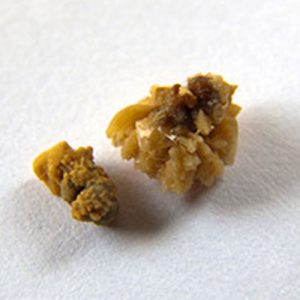
Calcium Oxalate Dihydrate / Calcium Oxalate Monohydrate Crystal
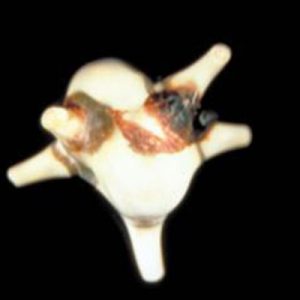
Calcium Oxalate Monohydrate / Apatite Crystal
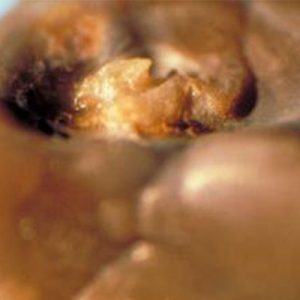
Calcium Oxalate Dihydrate Crystal
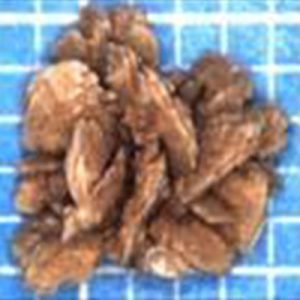
Calcium Phosphate Crystal
The word “calcium phosphate” has a precise term “basic calcium phosphate.” BCP crystals have a composition that is identical to both normal minerals found in bones and teeth. The etiology of pathologic basic calcium phosphate (BCP) crystal formation is not fully understood [2]. BCP mineral formation often occurs at sites of local tissue damage associated with injury or inflammation. The cause of calcium phosphate stones is often obscure but most often related to a high urine pH. Some patients with calcium phosphate stones may have incomplete renal tubular acidosis. Others have distal renal tubular acidosis characterized by hyperchloremic acidosis, hypocitraturia, and high urine pH.
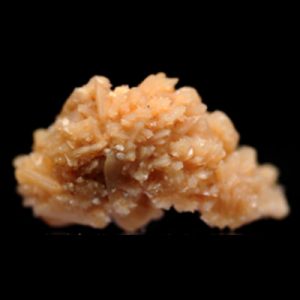
Calcium Oxalate Monohydrate Crystal
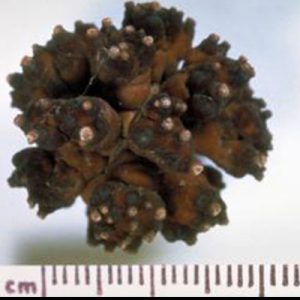
Uric Acid / Calcium Oxalate Monohydrate Crystal
The main crystalline component of the kidney stone matrix is calcium oxalate monohydrate (COM). It is common for a patient to have mixed uric acid and calcium oxalate stones, or to pass uric acid stones at some times and calcium oxalate at others. Gout is often an associated feature if has a uric acid component. Overall, approximately 5% of all stones are mixed calcium oxalate and uric acid.
Consuming an excessive amount of red meat, poultry, eggs, and seafood accomplishes two things. It causes your body to produce more uric acid. It can also deplete your system of citrate, a chemical that helps prevent kidney stones and possibly prevents current ones from developing.
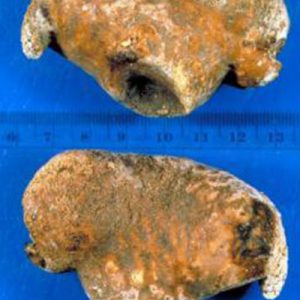
Calcium Oxalate Monohydrate with Superficial Dihydrate Crystal
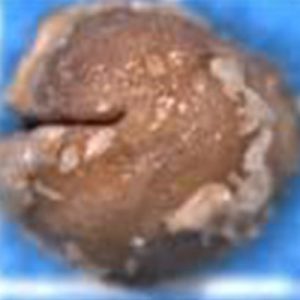
Calcium Oxalate Monohydrate Enveloping Uric Acid Crystal
This type of stone formation can run in families. Inherited issues with how the body processes uric acid or protein in the diet might cause a rise in urine acidity. This is evident in illnesses such as gout, a disorder in which people have high levels of uric acid in their blood and painful crystal deposits in their joints. Diabetes patients are also more likely to develop uric acid stones.
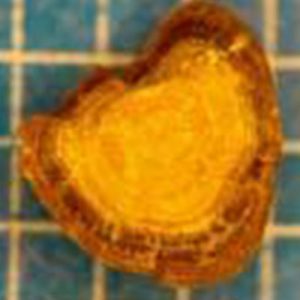
Calcium Oxalate Crystal with Uric Acid Nidus

Nephrolithiasis is one of the most common and expensive urologic disorders in the United States. Calcium oxalate is the most frequent type of kidney stone in humans, accounting for 75% of idiopathic stones in first-time stone formers. Stone creation is normally a slow process; however, certain conditions might hasten stone production and recurrence.
Thrombi in the urinary system can act as a nidus to produce a variety of kidney stones, including calcium oxalate and uric acid stones. Stones formed by such a nidus may develop at an abnormally fast rate.
The four main types of kidney crystals.
Calcium crystals are the most common kidney stone types. Calcium stones contain calcium oxalate, calcium phosphate, or a combination of the two. Calcium oxalate stones consist of calcium oxalate dihydrate, and calcium oxalate monohydrate. A calcium oxalate dihydrate crystal will have jagged edges, while the more common calcium oxalate monohydrate crystal will have will have a smooth surface.Uric acid crystals account for 5% to 10% of stones. Uric acid crystals are usually pebble-like in appearance. They are usually hard on the outside and soft on the inside, as they consist of different types of uric acid and calcium oxalate monohydrate.
Struvite crystals are the next most common type of stones, with 4% to 6% of people dealing with this type. Struvite stones are typically larger than others.
Cystine crystals are the result of cystinuria, which is a condition that can pass down through families.
